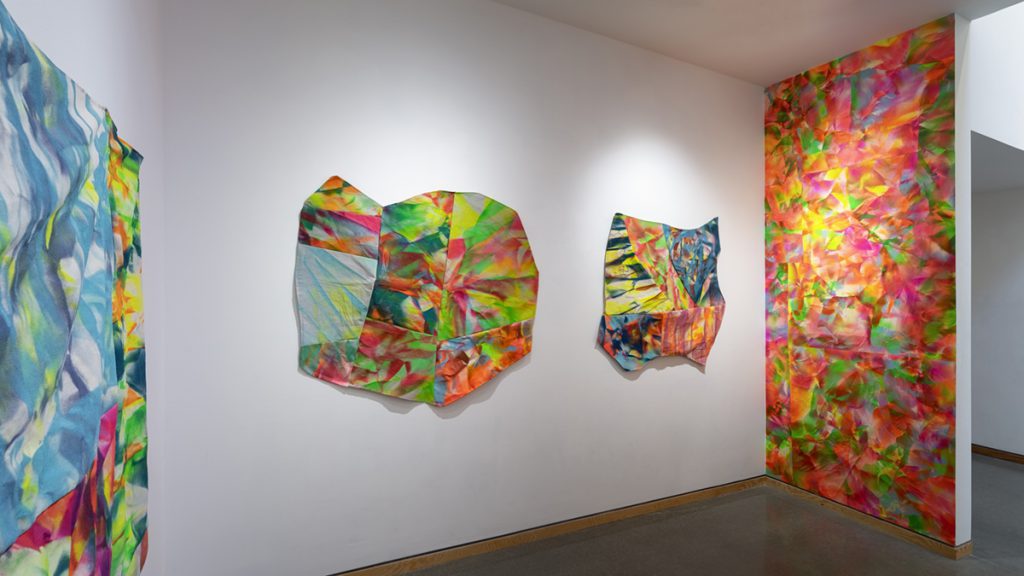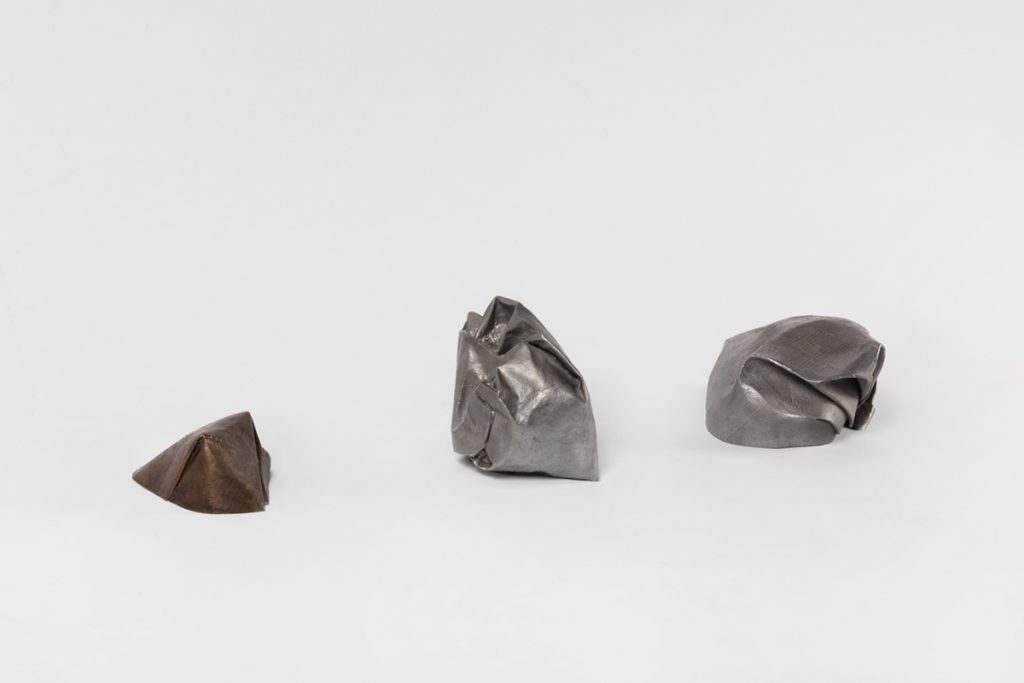Tie-Dye for Germans at Angell Gallery
8 September 2021
By Stephanie Cormier
Tie-Dye for Germans is an intimate and intensely radiant exhibition of paintings by Janine Miedzik in the Project Space at Angell Gallery. These new works have emerged by bringing together the ways Miedzik has previously approached materials, including a dialogue between her painterly and sculptural approaches to making work. Her combination of painting and sculpture in a spirited, perhaps even comical way, further materializes in the reciprocity between two different methods of working, and ways of seeing.
The cheeky title, Tie-Dye for Germans, was one of the entries in Chicago-based artist Scott Reeder’s list of Alternative Titles for Recent Exhibitions I’ve Seen.1 In true postmodern form, Toronto artist Janine Miedzik grabbed the title for her own exhibition—proving that the keenly observant art-world contradiction between a free-spirited, colour-embracing methodology and a staunch perfectionist one was just too enticing to pass up. Miedzik herself has found inspiration in this paradox, taking from our surrounding urban and suburban environments. Whether it be particular modern architecture and infrastructure, or simply the quick, gestural neon spray painted lines denoting construction zones, she is particularly interested in the supports we often don’t notice—scaffolds, colourful signs, and temporary tarp-covered blobs in our everyday travels. She pays special attention to job sites, retail displays, film sets and all of the temporary nomads in our built environment.
Similar to scaffolding, the paintings in the exhibition also engage in a more dynamic and impermanent presentation. Defying conventional hanging, the limp yet structured canvas seems to cling to the wall without the usual support of a stretcher. Almost like a quilt, piecing together different parts of her painted canvases, Miedzik constructs them back into whole configurations: like misshapen brightly coloured tarps that hide construction debris, or those wrapped around garden decor to protect them from outdoor elements. In this way, the paintings act more like “objects” than flat, pictorial planes.

The works in Tie-Dye For Germans move between quick rough gestures (such as crumpling) and precision. One of the canvas pieces, Fray (2020) is the combination of a square, circle, and hexagon. It is a seductive shape for a “painting,” with its peaked bottom and rounded top, which comes down the sides and back into a point at the top left corner. Fray is made up of at least seven patch-worked pieces hand sewn together, with different colour combinations painted and created using the tie-dye method, allowing additional wisps of colourful stripe patterns.
Treating two-dimensional canvas as a material to scrunch into sculptural shapes, Miedzik applies the saturated palette by spraying paint around the crumpled object, much like how one might move around a sculpture to view all of its sides. The canvas is then flattened back to its two-dimensional original, and the process is repeated with another colour. By continuing this back and forth between two- and three-dimensional form, Miedzik incorporates gestures of both painting and sculpture. After becoming aware of the artist’s process, it is easy to visually trace the lines of each colour to get an idea of its many previous ephemeral sculptural forms, before it was finalized into one flat surface.
Many of the works in Tie-Dye for Germans are large, irregular shapes with graphic tie-dye patterning; their patch-worked pieces operate like flexible, morphing grids. Miedzik takes inspiration from hard-edged abstraction and painters such as Frank Stella, who would muse about the confinement of corners in traditional rectangles.2 In the exhibition, she gives a nod to these forebears and continues the ongoing conversation with her influences, making strong lines yet defying borders, moving between systematic and free-form actions and moving away from the confines of the painter’s rectangle.
By paying attention to materials and colours with a focus on the temporary or the disposable in our environments, Miedzik has been able to generate new ideas that materialize in her work as painting, but also as sculptural objects, such as in Stuck 1, 2, and 3 (2018). These sculptures were on view in the Back Gallery at Angell Gallery (where they house other works by various artists the gallery represents). However, they gave a clue to the conception of the series of paintings that make up Tie-Dye for Germans in the Project Space. The works are light, crumpled bundles of used tape—amusingly presented in weighty, permanent bronze and aluminum. These small but chunky sculptures demonstrate an unrestrained “crumpling” method (as if to discard) that came to produce this new body of work.

There are many contrasting moments which strike the viewer in this exhibition. The humour, the tensions between disposability and permanence, or precision and improvisation, as well as colour. The bright, saturated colour palette is almost overwhelming, filling you so full to the brim that you have to catch your breath. Besides the obvious playfulness of a neon colour palette, the exhibition also acts as an antidote to the banality and bleakness of the everyday, and instead seeks a tangible joy. Can colour elicit a primordial sense, the sensation that Deleuze refers to when he places colour before cognition? The philosopher “held that colour sensation concurred with physiological data in the nervous system before intuition, interpretation, or organized emotions and affectations, even before sensory experience. In short, colour predated the organization of reason and cognitive sense.”3 In other words, you cannot not notice it.
The resist-dye method of tie-dye has its origins in many parts of the world—India, China, Indonesia, and Nigeria, to name a few—however, in the Western world it was largely associated with the hippy counterculture movement of the 1960s. From Woodstock and Deadheads, to children’s craft projects, this kitsch and colourful application exploded to accompany the psychedelic acid-trip aesthetic of the times. Attracted to this over-the-top effect, Miedzik chooses exaggerated colour but limits herself to the highly saturated Dayglo paint straight from the production line. Like white, fluorescent colours cannot be mixed from a primary colour palette. There isn’t so much a mixing to reveal personal choice here, but rather a process of spraying layer upon layer of pre-made luminescent colour that eventually leads to a more collaborative and stratified conglomeration.
The works in Tie-Dye for Germans hang closely and intimately in the small Project Space. The size of the space and the hanging style question painting norms: one canvas spans a corner and clings to two different walls for its support. The presentation of several paintings acts more as one immersive installation than to highlight each as an individual. The viewer is hit with a hedonistic shock of colour upon entering, revealing a comical exaggeration of the affect of painting, but also… just happiness. Who doesn’t need a tonic to remind us to keep things amusing and convivial, not to just work with what we are given or dealt, but to find a system that we can make joyful in our own way? Miedzik gives us something that is a bit more enjoyable and uncomplicated, while maybe even proving that we can still find brightness and amusement in the somberness of our current time.
- Scott Reeder, Alternative Titles for Recent Exhibitions I’ve Seen, and More Alternative Titles for Recent Exhibitions I’ve Seen, text-based works (Chicago, 2013-2015).
- Emile de Antonio (director), documentary – Painters Painting, featuring Frank Stella who describes painting that “gets into trouble in the corners” (USA, 1972).
- Carolyn L Kane, The Synthetic Color sense of Pipolitti Rist, or, Deleuzian color theory for electronic media art (Hunter College of the City University of New York, 2011): p. 479.
Tie-dye for Germans by Janine Miedzik ran from February 1 – March 7, 2020 at Angell Gallery in Toronto.
Feature Image: WUNDERBAR, 2020 by Janine Miedzik. Photo courtesy of the artist.


